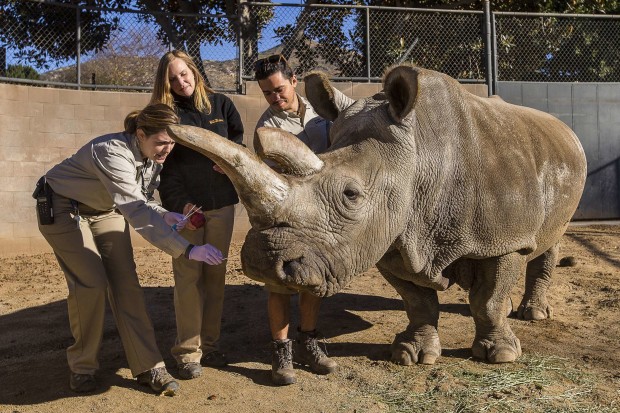

San Diego Zoo’s northern white rhino dies; only 3 left in the world
Archive 2015 Nov 23, 2015 Amrita Chopra

One of four of the world’s last remaining northern white rhinos died Sunday at the San Diego Zoo Safari Park.
Nola, the 41- year old rhino, was suffering from a bacterial infection and other age-related health issues.
According to the zoo’s website, her health took a turn for the worse on November 13th after undergoing a surgical procedure to drain a large pelvic abscess that caused the infection.
Nola was placed under close veterinary care as her appetite and activity began to decline, but after her condition began to significantly worsen caretakers decided to euthanize the animal, the zoo said in a statement.
The 1,800 kg animal was a staff favourite for her gentle disposition and fondness of getting her back scratched.
“We’re devastated by the loss of Nola,” the zoo in a tweeted on Sunday.
The rhino had been at the zoo since 1989, where she was brought as a part of a breeding program.
“Nola was an iconic animal, not only at the San Diego Zoo Safari Park, but worldwide,” the zoo said.
She was the only northern white rhino in the western hemisphere, while the remaining three of Nola’s kind live in Ol Pejeta Conservancy in Kenya, zoo officials said.
The subspecies of the white rhino was declared extinct in the wild in 2008.
Rhinos are illegally poached for their horns, which in some parts of the world are believed to to cure a range of illnesses, from hangovers to even cancer, says the World Wildlife Foundation.
The large creatures are said to be particularly vulnerable to hunting as they are relatively unaggressive and stay in herds.
The WWF says that the northern white rhino was once found in southern Chad, the Central African Republic, southwestern Sudan, northern parts of the Congo, and northwestern Uganda.
As recently as 1960, there were more than 2,000 remaining, but today’s numbers show that poaching has left the species with a bleak future.







